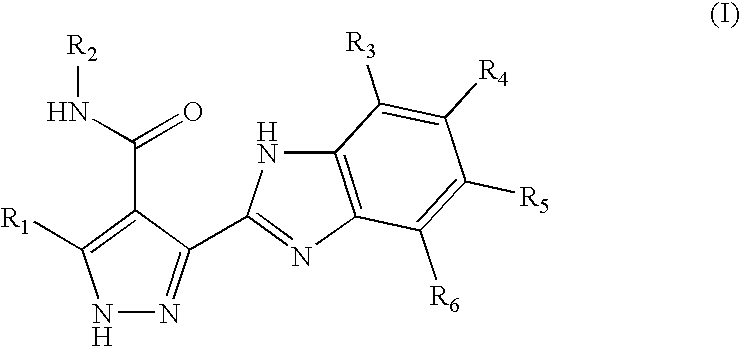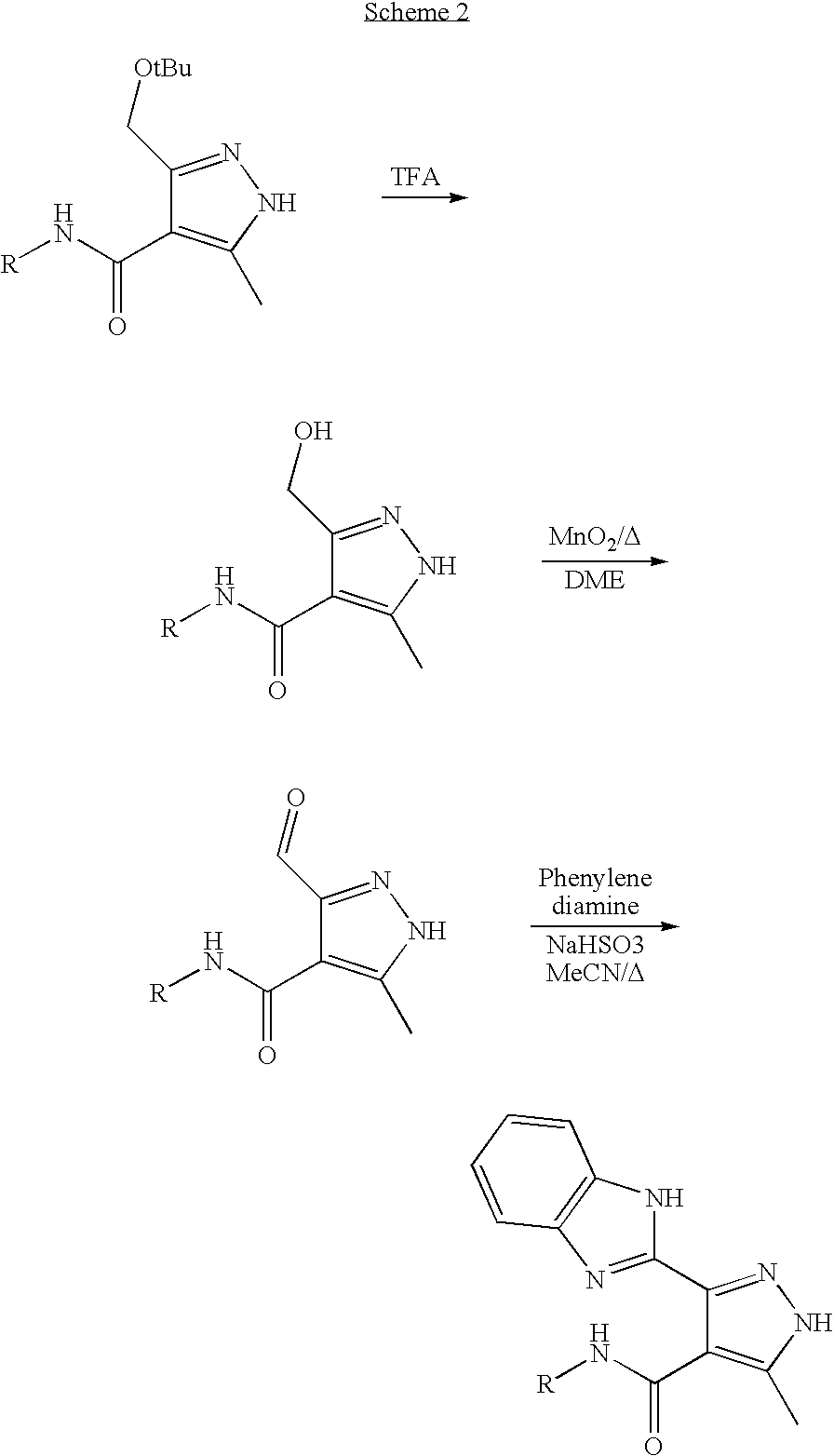Pyrazole-substituted benzimidazole derivatives for use in the treatment of cancer and autoimmune disorders
a technology of pyrazole and benzimidazole, which is applied in the direction of immunodeficiency, drug composition, biocide, etc., can solve the problems of cell cycle arrest, cancer cells that are less able to tolerate antisense-mediated reductions in pdk1 activity, and inappropriate activation of pathways
- Summary
- Abstract
- Description
- Claims
- Application Information
AI Technical Summary
Benefits of technology
Problems solved by technology
Method used
Image
Examples
reference example 1
Synthesis of 4-tert-Butoxy-3-oxo-butyric Acid Ethyl Ester
[0050]
[0051]A suspension of sodium hydride (70 g 60% dispersion in mineral oil) in dimethyl formamide (400 mls) at 0° C., was treated dropwise with ethyl-4-chloroacetate (90 g) and then with tert-butyl alcohol (81 g). The mixture was maintained at 0° C. and then allowed to warm to ambient temperature over 2 hours. The mixture was poured into 2N hydrochloric acid / ice (900 mls) and then extracted three times with ethyl acetate. The combined organics were dried over magnesium sulphate and evaporated. The resultant yellow oil residue was subjected to flash column chromatography on silica eluting gradient of hexane to (1:9, v / v) ethyl acetate and hexane to give title compound (76 g) as a yellow oil. 1H-NMR (400 MHz, CDCl3) δ H 1.20 (9H s) 1.25 (3H t), 3.54 (2H s), 4.00 (2H s), 4.19 (2H q)
reference example 2
Synthesis of 2-Acetyl-4-tert-butoxy-3-oxo-butyric Acid Ethyl Ester
[0052]
[0053]A solution of 4-tert-Butoxy-3-oxo-butyric acid ethyl ester (76 g) in dichloromethane (500 mls) was cooled in ice water bath and was treated with powdered 4 A° molecular sieves (40 g) and dry magnesium chloride (36 g). After 15 minutes the mixture was treated with pyridine (61 mls) over 5 minutes and stirring continued for 20 mins maintaining cooling. Acetyl chloride (27 mls) was added dropwise over 10 minutes with ice cooling & the whole allowed to warm to ambient temperature over 16 hours. The reaction was quenched with saturated ammonium chloride solution (300 mls) and the whole diluted with ethyl acetate (1 litre). The whole was filtered through a pad of celite and the layers partitioned. The organics were further washed with brine and dried over magnesium sulphate before being filtered and evaporated to yield 2-acetyl-4-tert-butoxy-3-oxo-butyric acid ethyl ester (88 g) as a yellow oil, which was used w...
reference example 3
Synthesis of 3-tert-Butoxymethyl-5-methyl-1H-pyrazole-4-carboxylic Acid Ethyl Ester
[0054]
[0055]A solution of 2-acetyl-4-tert-butoxy-3-oxo-butyric acid ethyl ester (88 g) in glacial acetic acid (600 mls) was treated dropwise with hydrazine hydrate (20 mls) and the mixture stirred at ambient temperature for 16 hrs. The reaction mixture was evaporated and partitioned between ethyl acetate and saturated sodium bicarbonate solution. The organics were dried over magnesium sulphate and evaporated. The residue was eluted through a pad of silica (600 g) eluting a gradient of hexane to (1:3, v / v) ethyl acetate and hexane. Evaporation of fractions afforded title compound as a golden oil which crystallised upon standing (74 g) 1H-NMR (400 MHz, D6 DMSO) δ H 1.19 (9H s), 1.26 (3H t), 2.34 (3H s), 4.18 (2H q), 4.54 (2H s broad).
PUM
| Property | Measurement | Unit |
|---|---|---|
| temperatures | aaaaa | aaaaa |
| temperature | aaaaa | aaaaa |
| temperature | aaaaa | aaaaa |
Abstract
Description
Claims
Application Information
 Login to View More
Login to View More - R&D
- Intellectual Property
- Life Sciences
- Materials
- Tech Scout
- Unparalleled Data Quality
- Higher Quality Content
- 60% Fewer Hallucinations
Browse by: Latest US Patents, China's latest patents, Technical Efficacy Thesaurus, Application Domain, Technology Topic, Popular Technical Reports.
© 2025 PatSnap. All rights reserved.Legal|Privacy policy|Modern Slavery Act Transparency Statement|Sitemap|About US| Contact US: help@patsnap.com



